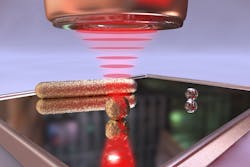MPQ resonator-cavity microscope enhances nanosystem imaging resolution
A team of scientists of the Laser Spectroscopy Division of professor Theodor W. Hänsch, director at the Max Planck Institute of Quantum Optics (MPQ; Garching, Germany) and chair for Experimental Physics at the Ludwig-Maximilians-Universität (Munich, Germany), has developed a technique whereby an optical microcavity is used to enhance optical signals by more than 1000-fold and at the same time achieve an optical resolution close to the fundamental diffraction limit.
RELATED ARTICLE: Tabletop high harmonics illuminate the nano-world
Conventional microscopes exceed their capabilities when particle size falls to the range of a few tens of nanometers where a single particle provides only a vanishingly small signal. As a consequence, many investigations are limited to large ensembles of particles.
Spectroscopic measurements on large ensembles of nanoparticles suffer from the fact that individual differences in size, shape, and molecular composition are washed out and only average quantities can be extracted. There is thus a large interest to develop single-particle-sensitive techniques. As detailed in Nature Communications, "Our approach is to trap the probe light used for imaging inside of an optical resonator, where it circulates tens of thousands of times. This enhances the interaction between the light and the sample, and the signal becomes easily measurable," says David Hunger, one of the scientists working on the experiment. "For an ordinary microscope, the signal would be only a millionth of the input power, which is hardly measurable. Because of the resonator, the signal gets enhanced by a factor of 50000."
In the microscope, built by David Hunger and his team, one side of the resonator is made of a plane mirror that serves at the same time as a carrier for the nanoparticles under investigation. The counterpart is a strongly curved mirror on the end facet of an optical fiber. Laser light is coupled into the resonator through this fiber. The plane mirror is moved point by point with respect to the fiber in order to bring the particle step by step into its focus. At the same time, the distance between both mirrors is adjusted such that the condition for the appearance of resonance modes is fulfilled. This requires an accuracy in the range of picometers.
For their first measurements, the scientists used gold spheres with a diameter of 40 nm. "The gold particles serve as our reference system, as we can calculate their properties precisely and therefore check the validity of our measurements," says Hunger. "Since we know the optical properties of our measurement apparatus very accurately, we can determine the optical properties of the particles from the transmission signal quantitatively and compare it to the calculation."
In contrast to other methods relying on direct signal enhancement, the light field is limited to a very small area, such that by using only the fundamental mode, a spatial resolution of 2 microns is achieved. By combining higher order modes, the scientists could even increase the resolution to around 800 nm.
The method becomes even more powerful when both absorptive and dispersive properties of a single particle are determined at the same time. This is interesting especially if the particles are not spherical but elongated. Then, the corresponding quantities depend on the orientation of the polarization of light with respect to the symmetry axes of the particle.
"As an application of our method, we could think of e.g. investigating the temporal dynamics of macro molecules, such as the folding dynamics of proteins," says Hunger. "Overall we see a large potential for our method: from the characterization of nanomaterials and biological nanosystems to spectroscopy of quantum emitters."
SOURCE: MPQ; http://www.mpq.mpg.de/5174257/15_06_24
About the Author

Gail Overton
Senior Editor (2004-2020)
Gail has more than 30 years of engineering, marketing, product management, and editorial experience in the photonics and optical communications industry. Before joining the staff at Laser Focus World in 2004, she held many product management and product marketing roles in the fiber-optics industry, most notably at Hughes (El Segundo, CA), GTE Labs (Waltham, MA), Corning (Corning, NY), Photon Kinetics (Beaverton, OR), and Newport Corporation (Irvine, CA). During her marketing career, Gail published articles in WDM Solutions and Sensors magazine and traveled internationally to conduct product and sales training. Gail received her BS degree in physics, with an emphasis in optics, from San Diego State University in San Diego, CA in May 1986.
